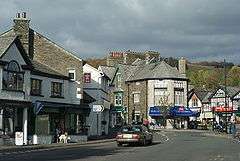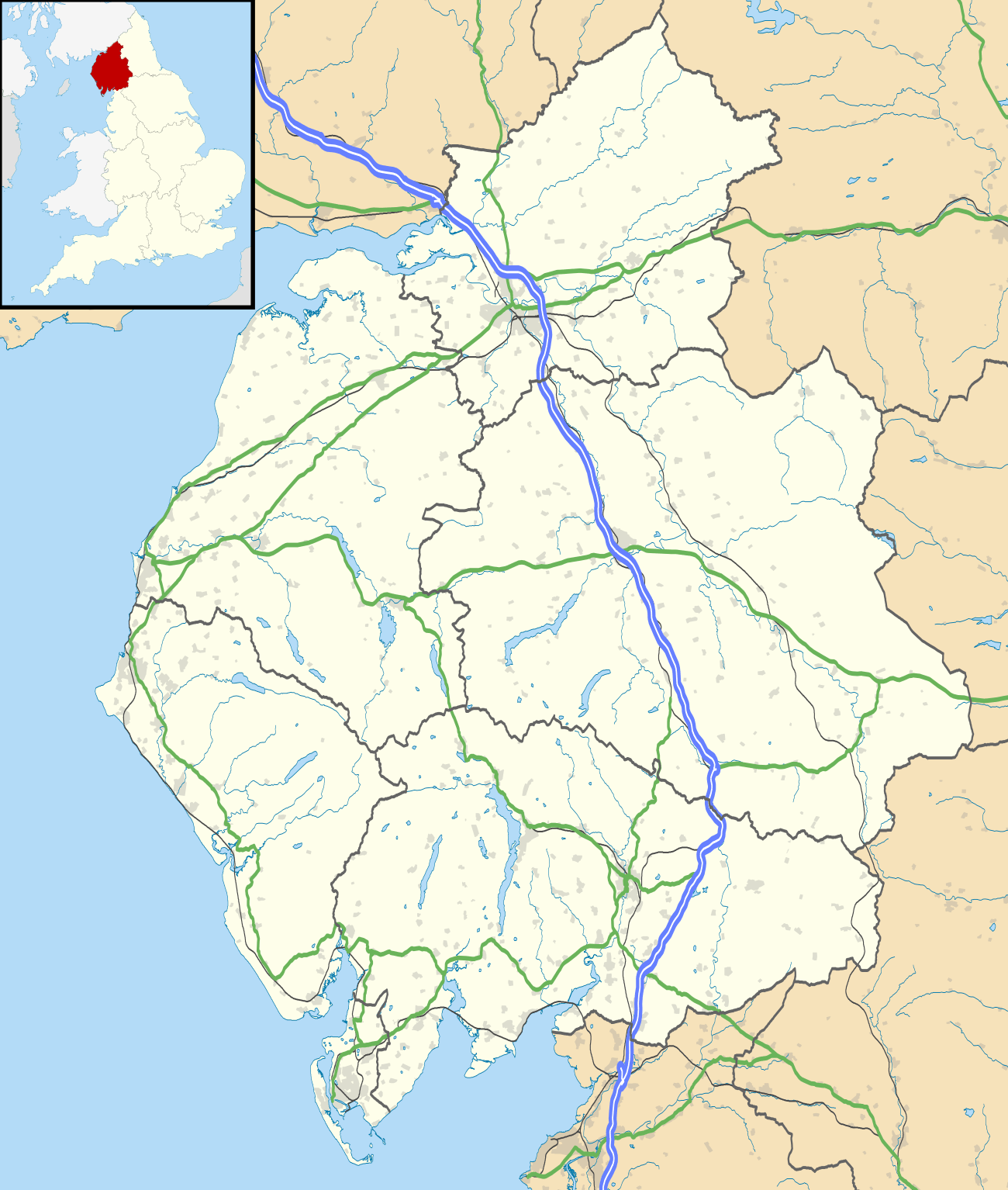Windermere, Cumbria (town)
| Windermere | |
|---|---|
 Windermere town centre | |
 Windermere Windermere shown within Cumbria | |
| Population | 8,359 (2011)[1] |
| OS grid reference | SD4198 |
| Civil parish |
|
| District | |
| Shire county | |
| Region | |
| Country | England |
| Sovereign state | United Kingdom |
| Post town | WINDERMERE |
| Postcode district | LA23 |
| Dialling code | 015394 |
| Police | Cumbria |
| Fire | Cumbria |
| Ambulance | North West |
| EU Parliament | North West England |
| UK Parliament | |
Windermere is a town and civil parish in the South Lakeland District of Cumbria, England. It has a population of 8,245[3] increasing to 8,359 at the 2011 Census, and lies about half a mile (1 km) away from the lake, Windermere.[4] Although the town Windermere does not touch the lake (it took the name of the lake when the railway line was built in 1847 and the station was called "Windermere"), it has now grown together with the older lakeside town of Bowness-on-Windermere, though the two retain distinguishable town centres. Tourism is popular in the town owing to its proximity to the lake and local scenery. Boats from the piers in Bowness sail around the lake, many calling at Ambleside or at Lakeside where there is a restored railway. Windermere Hotel opened at the same time as the railway.
History
Historically a part of Westmorland, Windermere town was known as Birthwaite prior to the arrival of the Kendal and Windermere Railway, which stimulated its development. Windermere station offers train and bus connections to the surrounding area, Manchester Airport and the West Coast Main Line.
The geological formations around the area take their name from the town. They are called the Windermere Group of sedimentary rocks. The town's name is also given to the Rt. Hon. Dr David Clark, Baron Clark of Windermere, who now lives in Windermere.
Etymology
The word "Windermere" is thought to translate as "Winand or Vinand's lake". The specific has usually been identified with an Old Swedish personal name Vinandr. The other possibility is for a Continental Germanic name Wīnand.[5] The second element is Old English 'mere', meaning 'lake' or 'pool'. There is a reference to "Wynandermer" in 1396.[6]
Governance
Windermere was from 1894 to 1974 governed by an urban district council which in 1905 absorbed the former Bowness-on-Windermere UDC although Bowness remained a separate civil parish until 1974. Windermere UDC had slight boundary changes in 1934 and was abolished by the Local Government Act 1972 replacing it with South Lakeland District Council. The Windermere coat of arms was commissioned in 1968 and designed by local schoolgirl, Sheila West.
Transport
Windermere railway station was built in 1847, and was the reason the town was established.[7] The station serves trains run by Northern to Oxenholme on the West Coast Main Line. There are also services to Manchester Airport.[8]
The town is near the A591, a major road running through the Lake District from Kendal to Keswick.
Education
There are three primary schools located in the town. Secondary education is provided by The Lakes School (state) and Windermere School (independent, ages 2-18), both of which are located on the outskirts.
See also
References
- ↑ "Town population 2011". Retrieved 13 June 2015.
- ↑ http://www.windermere-tc.gov.uk/
- ↑ Office for National Statistics : Census 2001 : Parish headcounts : South Lakeland Retrieved 22 November 2009
- ↑ "Pictures of Windermere". Picturesofengland.com. Retrieved 31 May 2013.
- ↑ Whaley, Diana (2006). A dictionary of Lake District place-names. Nottingham: English Place-Name Society. pp. lx, 423 p.374. ISBN 0904889726.
- ↑ Plea Rolls of the Court of Common Pleas: CP 40/541; http://aalt.law.uh.edu/AALT6/R2/CP40no541a/aCP40no541afronts/IMG_0077.htm; 4th entry; animals being taken from John Burgh by 2 guys from Wynandermer
- ↑ Reid, Jim (2011). Tour of the Lake District. Cicerone Press Limited. p. 66. ISBN 978-1-849-65465-4.
- ↑ "Train Timetables". Transpennine Express. Retrieved 22 January 2016.
External links
| Wikimedia Commons has media related to Windermere. |
| Wikivoyage has a travel guide for Windermere. |
- Windermere Town Council
- Cumbria County History Trust: Windermere and Bowness
- The Cumbria Directory - Windermere